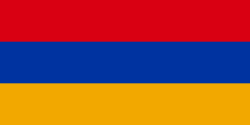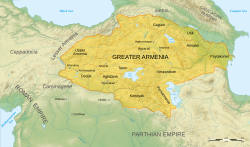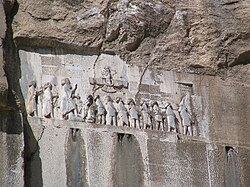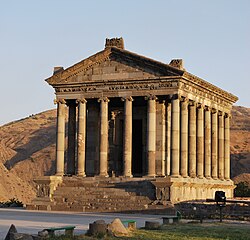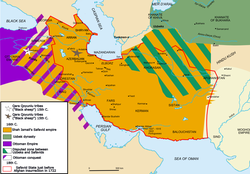Armenia
Armenia (Armenian: Հայաստան, romanized: Hayastān), officially the Republic of Armenia,[a] is a landlocked country located in the Armenian Highlands in the Caucasus, spanning Eastern Europe and Western Asia.[5][6][7][8]
Republic of Armenia Հայաստանի Հանրապետություն Hayastani Hanrapetut'yun | |
|---|---|
| Motto: | |
| Anthem: | |
 Location of Armenia (green) | |
| Capital and largest city | Yerevan 40°11′N 44°31′E / 40.183°N 44.517°E |
| Armenian[1] | |
| Ethnic groups (2011) | |
| Religion (2011) |
|
| Demonym(s) | Armenian |
| Government | Unitary parliamentary republic |
• President | Vahagn Khachaturyan |
• Prime Minister | Nikol Pashinyan |
• President of the National Assembly | Alan Simonyan |
| Legislature | National Assembly |
| Establishment history | |
• Patriarch Hayk | 2492 BC |
• Kingdom of Urartu | 860 BC–590 BC |
• Kingdom of Armenia (antiquity) | 321 BC–428 AD |
• Kingdom of Armenia (medieval) | 885–1045 |
| 1198–1375 | |
• First Republic of Armenia | 28 May 1918 |
• Soviet conquest | 29 November 1920 |
• Indepence restored | 23 September 1991 |
• CIS Accesion | 21 December 1991 |
• Admitted to the United Nations | 2 March 1992 |
• Current constitution | 5 July 1995 |
| Area | |
• Total | 29,743[3] km2 (11,484 sq mi) (147th) |
• Land | 28,203[3] km2 (10,889 sq mi) |
• Water | 1,540[3] km2 (590 sq mi) |
| Population | |
• CIA 2022 estimate | 3,000,756[3] (138th) |
• 2011 census | 3,018,854 |
• Density | 101.5/km2 (262.9/sq mi) (99th) |
| GDP (PPP) | 2021 estimate |
• Total | $43.550 billion[4] |
• Per capita | $14,701[4] |
| GDP (nominal) | 2021 estimate |
• Total | $13.612 billion[4] (127th) |
• Per capita | $4,595[4] (104th) |
| Gini (2019) | ▼ 29.9 low |
| HDI (2019) | high · 81st |
| Currency | Dram (֏) (AMD) |
| Time zone | UTC+4 (AMT) |
| Driving side | right |
| Calling code | +374 |
| ISO 3166 code | AM |
| Internet TLD | |
History
The Hittites and Hayasa-Azzi may have played a significant role in the ethnicity of Armenians. It has an ancient cultural heritage. One of the earliest Armenian kingdoms such as Urartu was established in 860 BC and by the 6th century BC it was replaced by the Satrapy of Armenia. The Kingdom of Armenia reached its height under Tigranes the Great in the 1st century BC and became the first state in the world to adopt Christianity as its official state religion in the late 3rd or early 4th century AD.[9][10][11] The official date of state adoption of Christianity is 301.[12]
Foreign invasion
Between the 16th century and 19th century, the traditional Armenian homeland composed of Eastern Armenia and Western Armenia came under the rule of the Ottoman and Iranian empires, repeatedly ruled by either of the two over the centuries. By the 19th century, Eastern Armenia had been conquered by the Russian Empire, while most of the western parts of the traditional Armenian homeland remained under Ottoman rule.
20th century
During World War I, Armenians living in their ancestral lands in the Ottoman Empire were systematically exterminated in the Armenian Genocide, perpetrated by Ottoman Young Turks. Around 1.5 million people were slaughtered and many more deported. In 1918, following the Russian Revolution, the Russian Empire ceased to exist and all non-Russian countries declared their independence. This led to the establishment of the First Republic of Armenia. By 1920, the state was incorporated into the Transcaucasian Socialist Federative Soviet Republic, and in 1922 became a founding member of the Soviet Union. In 1936, the Transcaucasian state was dissolved, transforming its constituent states, including the Armenian Soviet Socialist Republic, into full Union republics. The modern Republic of Armenia became independent in 1991 during the dissolution of the Soviet Union.
21st century
Administrative divisions
Armenia is divided into ten provinces, with the city of Yerevan having special administrative status as the country's capital. The chief executive in each of the ten provinces is the marzpet (marz governor), appointed by the government of Armenia. In Yerevan, the chief executive is the mayor, appointed by the president.
As of 2007[update], Armenia includes 915 communities, of which 49 are considered urban and 866 are considered rural.
| Province | Capital | Area (km²) | Population † | ||
|---|---|---|---|---|---|
| Aragatsotn | Արագածոտն | Ashtarak | Աշտարակ | 2,756 | 132,925 |
| Ararat | Արարատ | Artashat | Արտաշատ | 2,090 | 260,367 |
| Armavir | Արմավիր | Armavir | Արմավիր | 1,242 | 265,770 |
| Gegharkunik | Գեղարքունիք | Gavar | Գավառ | 5,349 | 235,075 |
| Kotayk | Կոտայք | Hrazdan | Հրազդան | 2,086 | 254,397 |
| Lori | Լոռի | Vanadzor | Վանաձոր | 3,799 | 235,537 |
| Shirak | Շիրակ | Gyumri | Գյումրի | 2,680 | 251,941 |
| Syunik | Սյունիք | Kapan | Կապան | 4,506 | 141,771 |
| Tavush | Տավուշ | Ijevan | Իջևան | 2,704 | 128,609 |
| Vayots Dzor | Վայոց Ձոր | Yeghegnadzor | Եղեգնաձոր | 2,308 | 52,324 |
| Yerevan | Երևան | – | – | 223 | 1,060,138 |
† 2011 census
Sources: Area and population of provinces.[13]
Culture
Armenia is a majority Christian country, with European and some wider Eurasian cultural influences.[14] The Republic of Armenia recognizes the Armenian Apostolic Church, the world's oldest national church, as the country's primary religious establishment.[15][16] The unique Armenian alphabet was invented by Mesrop Mashtots in 405 AD. Armenia also has a minority of Yazidis who settled in the country after fleeing persecution and have long established themselves into the wider Armenian society and have been integrated into the country. They speak both Armenian and their native Kurmanji.
Armenia is a member of the Council of Europe, the Eurasian Economic Union and the Collective Security Treaty Organization. Armenia supports the de facto independent Republic of Artsakh, which was proclaimed in 1991.
Gallery
- Armenia
Sevanavank church on the shore of Lake Sevan
Armenia Media
Armenian national anthem performed by the U.S. Navy Band.*
Bronze Age burial site Zorats Karer (also known as Karahunj)
Petroglyphs with images of various animals on Mount Ughtasar
Behistun Inscription of Darius I mentioning Armenia. 6th century BC.
Coin of Tigranes the Great
The pagan Garni Temple, probably built in the first century, is the only "Greco-Roman colonnaded building" in the post-Soviet space.
The Etchmiadzin Cathedral, Armenia's Mother Church traditionally dated 303 AD, is considered the oldest cathedral in the world.
In 1501–02, most of the Eastern Armenian territories, including Yerevan, were conquered by the emerging Safavid dynasty of Iran led by Shah Ismail I.
Capture of Erivan fortress by Russian troops in 1827 during the Russo-Persian War (1826–28) by Franz Roubaud
References
- ↑ Constitution of the Republic of Armenia,
Article 20:The state language of the Republic of Armenia shall be the Armenian language.
- ↑ According to the 2011 Armenian census, the total population of the country is 3,018,854, and the Armenian population is 2,961,514. This means that 98.1% of the population is Armenian. Others make up the remaining 1.9% (57,340) population.
- ↑ 3.0 3.1 3.2 3.3 "Armenia". The World Factbook. Central Intelligence Agency (United States).
- ↑ 4.0 4.1 4.2 4.3 "World Economic Outlook Database, October 2021". IMF.org. International Monetary Fund. Retrieved 3 January 2022.
- ↑ The UN classification of world regions Archived 25 June 2002 at the Wayback Machine places Armenia in Western Asia; the CIA World Factbook "Armenia". The World Factbook. CIA. Retrieved 2 September 2010. "Armenia". National Geographic. Archived from the original on 8 August 2007. Retrieved 16 April 2009., "Armenia". Encyclopædia Britannica. Archived from the original on 1 April 2009. Retrieved 16 April 2009., Calendario Atlante De Agostini (in italiano) (111 ed.). Novara: Istituto Geografico De Agostini. 2015. p. sub voce. ISBN 9788851124908. and Oxford Reference Online "Oxford Reference". World Encyclopedia. Oxford Reference Online. 2004. doi:10.1093/acref/9780199546091.001.0001. ISBN 9780199546091. also place Armenia in Asia.
- ↑ "Armenia Country Overview | World Health Organization". www.who.int. Retrieved 2023-07-07.
- ↑ "Armenia". Nations Online. Retrieved 7 July 2023.
- ↑ "Council of Europe Office in Yerevan - Council of Europe Office in Yerevan - www.coe.int". Council of Europe Office in Yerevan. Retrieved 2023-07-07.
- ↑ (Garsoïan, Nina (1997). R.G. Hovannisian (ed.). Armenian People from Ancient to Modern Times. Palgrave Macmillan. p. 81, Vol. 1.)
- ↑ Stringer, Martin D. (2005). A Sociological History of Christian Worship. Cambridge: Cambridge University Press. p. 92. ISBN 0-521-81955-5.
- ↑ Smaller nations that have claimed a prior official adoption of Christianity include Osroene, the Silures, and San Marino. See Timeline of official adoptions of Christianity.
- ↑ Grousset, René (1947). Histoire de l'Arménie (1984 ed.). Payot. p. 122.. Estimated dates vary from 284 to 314. Garsoïan (op.cit. p. 82), following the research of Ananian, favours the latter.
- ↑ "Armstat:Provinces, area and population" (PDF). Archived (PDF) from the original on 10 October 2017. Retrieved 26 January 2014.
- ↑ "The Other Side of Europe: Armenia". My Country? Europe. 2020-05-07. Retrieved 2023-05-09.
- ↑ The republic has separation of church and state
- ↑ "The Constitution of the Republic of Armenia, Article 8.1". President.am. Archived from the original on 20 December 2010. Retrieved 30 December 2010.
Notes
- ↑ Armenian: Հայաստանի Հանրապետություն, romanized: Hayastani Hanrapetut'yun
